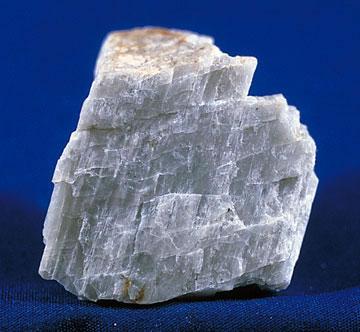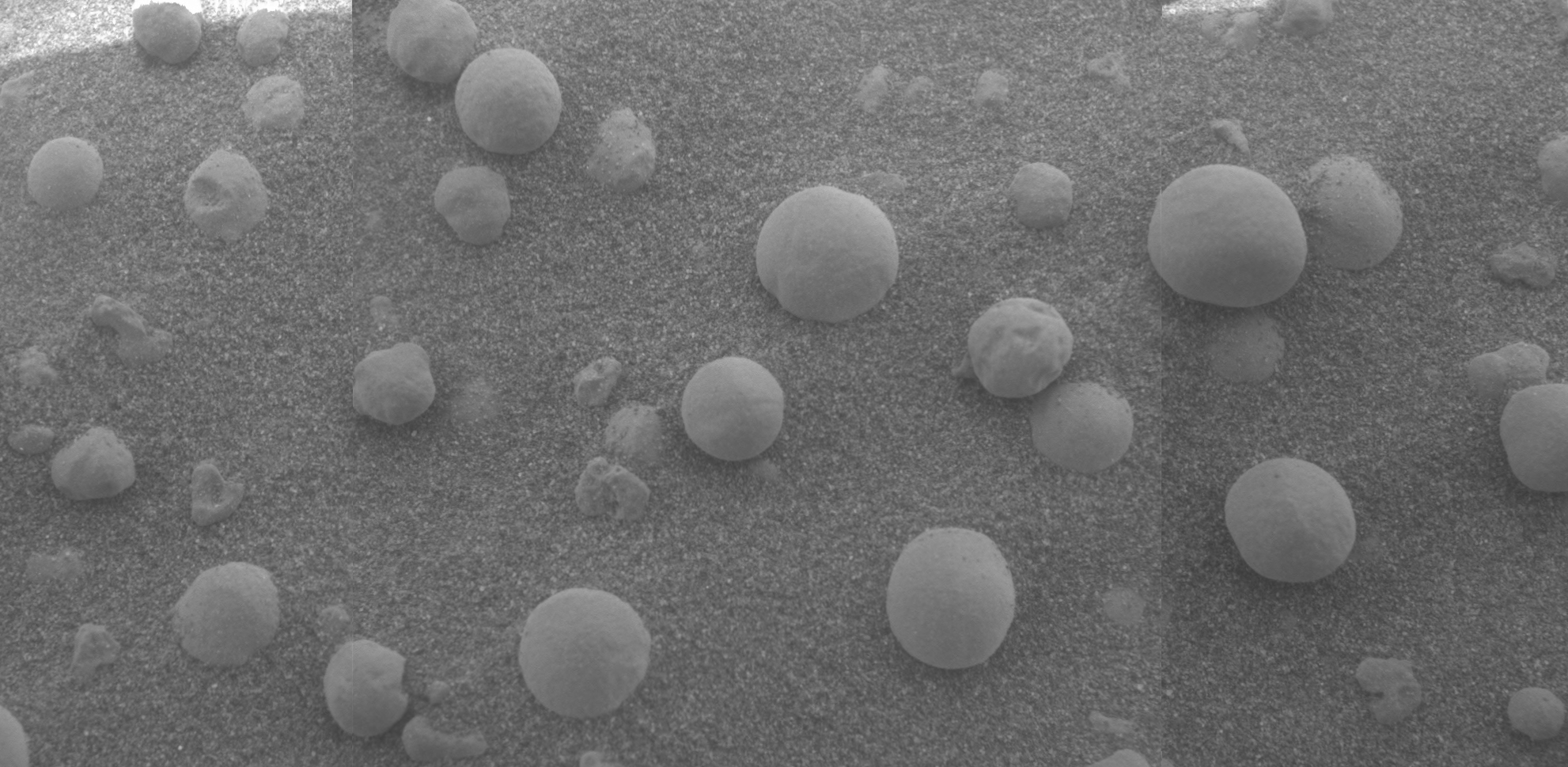|
Oligoclase
Oligoclase is a rock-forming mineral belonging to the plagioclase feldspars. In chemical composition and in its crystallographic and physical characters it is intermediate between albite ( Na Al Si3 O8) and anorthite ( CaAl2Si2O8). The albite:anorthite molar ratio of oligoclase ranges from 90:10 to 70:30. Oligoclase is a high sodium feldspar crystallizing in the triclinic system. The Mohs hardness is 6 to 6.5 and the specific gravity is 2.64 to 2.66. The refractive indices are: nα = 1.533–1.543, nβ = 1.537–1.548, and nγ = 1.542–1.552. In color it is usually white, with shades of grey, green, or red. Oligoclase is a common mineral in the more silica-rich varieties of igneous rock and in many metamorphic rocks. Name and discovery The name oligoclase was given by August Breithaupt in 1826 from the , little, and , to break, because the mineral was thought to have a less perfect cleavage than albite. It had previously been recognized as a distinct species by J. J. Berzel ... [...More Info...] [...Related Items...] OR: [Wikipedia] [Google] [Baidu] |
Plagioclase
Plagioclase ( ) is a series of Silicate minerals#Tectosilicates, tectosilicate (framework silicate) minerals within the feldspar group. Rather than referring to a particular mineral with a specific chemical composition, plagioclase is a continuous solid solution series, more properly known as the plagioclase feldspar series. This was first shown by the German mineralogist Johann F. C. Hessel, Johann Friedrich Christian Hessel (1796–1872) in 1826. The series ranges from albite to anorthite endmembers (with respective compositions NaAlSi3O8 to CaAl2Si2O8), where sodium and calcium atoms can substitute for each other in the mineral's crystallography, crystal lattice structure. Plagioclase in hand samples is often identified by its polysynthetic crystal twinning or "phonograph record, record-groove" effect. Plagioclase is a major constituent mineral in Earth's crust and is consequently an important diagnostic tool in petrology for identifying the composition, origin and evolutio ... [...More Info...] [...Related Items...] OR: [Wikipedia] [Google] [Baidu] |
Tectosilicate
Silicate minerals are rock-forming minerals made up of silicate groups. They are the largest and most important class of minerals and make up approximately 90 percent of Earth's crust. In mineralogy, the crystalline forms of silica (silicon dioxide, ) are usually considered to be tectosilicates, and they are classified as such in the Dana system (75.1). However, the Nickel-Strunz system classifies them as oxide minerals (4.DA). Silica is found in nature as the mineral quartz, and its polymorphs. On Earth, a wide variety of silicate minerals occur in an even wider range of combinations as a result of the processes that have been forming and re-working the crust for billions of years. These processes include partial melting, crystallization, fractionation, metamorphism, weathering, and diagenesis. Living organisms also contribute to this geologic cycle. For example, a type of plankton known as diatoms construct their exoskeletons ("frustules") from silica extracted from sea ... [...More Info...] [...Related Items...] OR: [Wikipedia] [Google] [Baidu] |
Silica
Silicon dioxide, also known as silica, is an oxide of silicon with the chemical formula , commonly found in nature as quartz. In many parts of the world, silica is the major constituent of sand. Silica is one of the most complex and abundant families of materials, existing as a compound of several minerals and as a synthetic product. Examples include fused quartz, fumed silica, opal, and aerogels. It is used in structural materials, microelectronics, and as components in the food and pharmaceutical industries. All forms are white or colorless, although impure samples can be colored. Silicon dioxide is a common fundamental constituent of glass. Structure In the majority of silicon dioxides, the silicon atom shows Tetrahedral molecular geometry, tetrahedral coordination, with four oxygen atoms surrounding a central Si atomsee 3-D Unit Cell. Thus, SiO2 forms 3-dimensional network solids in which each silicon atom is covalently bonded in a tetrahedral manner to 4 oxygen atoms. ... [...More Info...] [...Related Items...] OR: [Wikipedia] [Google] [Baidu] |
Orthoclase
Orthoclase, or orthoclase feldspar ( endmember formula K Al Si3 O8), is an important tectosilicate mineral which forms igneous rock. The name is from the Ancient Greek for "straight fracture", because its two cleavage planes are at right angles to each other. It is a type of alkali feldspar, also known as potassium feldspar or K-spar. The gem known as moonstone (see below) is largely composed of orthoclase. Formation and subtypes left, Orthoclase Organ_Mountains.html" ;"title="crystal twinning from the Organ Mountains">crystal twinning from the Organ Mountains in New Mexico Orthoclase is a common constituent of most granites and other felsic igneous rocks and often forms huge crystals and masses in pegmatite. Typically, the pure potassium endmember of orthoclase forms a solid solution with albite, the sodium endmember (NaAlSi3O8) of plagioclase. While slowly cooling within the earth, sodium-rich albite lamellae form by exsolution, enriching the remaining orthocla ... [...More Info...] [...Related Items...] OR: [Wikipedia] [Google] [Baidu] |
Hematite
Hematite (), also spelled as haematite, is a common iron oxide compound with the formula, Fe2O3 and is widely found in rocks and soils. Hematite crystals belong to the rhombohedral lattice system which is designated the alpha polymorph of . It has the same crystal structure as corundum () and ilmenite (). With this it forms a complete solid solution at temperatures above . Hematite occurs naturally in black to steel or silver-gray, brown to reddish-brown, or red colors. It is mined as an important ore mineral of iron. It is electrically conductive. Hematite varieties include ''kidney ore'', ''martite'' ( pseudomorphs after magnetite), ''iron rose'' and ''specularite'' ( specular hematite). While these forms vary, they all have a rust-red streak. Hematite is not only harder than pure iron, but also much more brittle. The term ''kidney ore'' may be broadly used to describe botryoidal, mammillary, or reniform hematite. Maghemite is a polymorph of hematite (γ-) with the ... [...More Info...] [...Related Items...] OR: [Wikipedia] [Google] [Baidu] |
Norway
Norway, officially the Kingdom of Norway, is a Nordic countries, Nordic country located on the Scandinavian Peninsula in Northern Europe. The remote Arctic island of Jan Mayen and the archipelago of Svalbard also form part of the Kingdom of Norway. Bouvet Island, located in the Subantarctic, is a Dependencies of Norway, dependency, and not a part of the Kingdom; Norway also Territorial claims in Antarctica, claims the Antarctic territories of Peter I Island and Queen Maud Land. Norway has a population of 5.6 million. Its capital and largest city is Oslo. The country has a total area of . The country shares a long eastern border with Sweden, and is bordered by Finland and Russia to the northeast. Norway has an extensive coastline facing the Skagerrak strait, the North Atlantic Ocean, and the Barents Sea. The unified kingdom of Norway was established in 872 as a merger of Petty kingdoms of Norway, petty kingdoms and has existed continuously for years. From 1537 to 1814, Norway ... [...More Info...] [...Related Items...] OR: [Wikipedia] [Google] [Baidu] |
Tvedestrand
is List of municipalities of Norway, municipality in Agder counties of Norway, county, Norway. It is located in the Districts of Norway, traditional district of Southern Norway, Sørlandet. The administrative center is the Tvedestrand (town), town of Tvedestrand. There are many villages in the municipality including Dypvåg (village), Dypvåg, Fiane, Tvedestrand, Fiane, Gjeving, Gødderstad, Grønland, Agder, Grønland, Kilen, Tvedestrand, Kilen, Klåholmen, Kråkvåg, Agder, Krokvåg, Laget, Lyngør, Nesgrenda, Østerå, Sagesund, Sandvika, Agder, Sandvika, and Songe. The Tvedestrand (town), town of Tvedestrand has a white-painted town center with irregular streets climbing steep hills around the harbor. The natural environment of the area makes it a tourist destination. The municipality includes numerous islands, which makes it popular in the summer for boaters. The number of people in the municipality practically doubles in the summer, due to vacationers. There are approximat ... [...More Info...] [...Related Items...] OR: [Wikipedia] [Google] [Baidu] |
Gneiss
Gneiss (pronounced ) is a common and widely distributed type of metamorphic rock. It is formed by high-temperature and high-pressure metamorphic processes acting on formations composed of igneous or sedimentary rocks. This rock is formed under pressures ranging from 2 to 15 kbar, sometimes even more, and temperatures over 300 °C (572 °F). Gneiss nearly always shows a banded texture characterized by alternating darker and lighter colored bands and without a distinct Cleavage (geology), cleavage. Gneisses are common in the ancient crust of Continental Shield, continental shields. Some of the oldest rocks on Earth are gneisses, such as the Acasta Gneiss. Description image:Orthogneiss Geopark.jpg, Orthogneiss from the Czech Republic In traditional English and North American usage, a gneiss is a coarse-grained metamorphic rock showing compositional banding (gneissic banding) but poorly developed schistosity and indistinct Cleavage (geology), cleavage. In other words, it i ... [...More Info...] [...Related Items...] OR: [Wikipedia] [Google] [Baidu] |
Aventurine
Aventurine is a form of quartzite, characterised by its translucency and the presence of platy mineral inclusions that give it a shimmering or glistening effect termed '' aventurescence''. Background The most common color of aventurine is green, but it can also be orange, brown, yellow, blue, or grey. Chrome-bearing fuchsite (a variety of muscovite mica) is the classic inclusion and gives a silvery green or blue sheen. Oranges and browns are attributed to hematite or goethite. Because aventurine is a rock, its physical properties vary: its specific gravity may lie between 2.64–2.69 and its hardness is somewhat lower than single-crystal quartz at around 6.5. Aventurine feldspar or sunstone can be confused with orange and red aventurine quartzite, although the former is generally of a higher transparency. Aventurine is often banded and an overabundance of fuchsite may render it opaque, in which case it may be mistaken for malachite at first glance. The name ''aventurine'' de ... [...More Info...] [...Related Items...] OR: [Wikipedia] [Google] [Baidu] |
Gemstone
A gemstone (also called a fine gem, jewel, precious stone, semiprecious stone, or simply gem) is a piece of mineral crystal which, when cut or polished, is used to make jewellery, jewelry or other adornments. Certain Rock (geology), rocks (such as lapis lazuli, opal, and obsidian) and occasionally organic chemistry, organic materials that are not minerals (such as amber, Jet (gemstone), jet, and pearl) may also be used for jewelry and are therefore often considered to be gemstones as well. Most gemstones are hard, but some softer minerals such as brazilianite may be used in jewelry because of their color or Lustre (mineralogy), luster or other physical properties that have aesthetic value. However, generally speaking, soft minerals are not typically used as gemstones by virtue of their brittleness and lack of durability. Found all over the world, the industry of coloured gemstones (i.e. anything other than diamonds) is currently estimated at US$1.55billion and is projected to s ... [...More Info...] [...Related Items...] OR: [Wikipedia] [Google] [Baidu] |
Bakersville, North Carolina
Bakersville is a town in Mitchell County, North Carolina, United States. The population was 450 at the 2020 census. It is the county seat of Mitchell County. History In prehistoric times, local mica deposits were extensively mined by Native Americans. The first Euro-American settlers arrived in the area after the American Revolution, establishing scattered homesteads. The town of Bakersville dates from the 1850s and was named for David Baker, a Revolutionary War soldier and one of the first to live in the area around 1790 and described as "a large land owner, innkeeper, merchant and political leader until his death in 1838. Some of David's sons and daughters remained and were equally influential in the area for many years after David's death." Situated on the main route leading over Roan Mountain and westward into Tennessee, the town developed slowly. Traveler Frederick Law Olmsted passed through Bakersville in the early 1850s and noted that the "town" consisted of only a coup ... [...More Info...] [...Related Items...] OR: [Wikipedia] [Google] [Baidu] |








